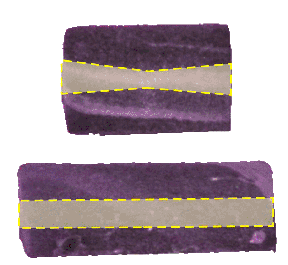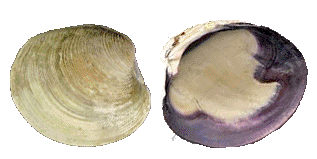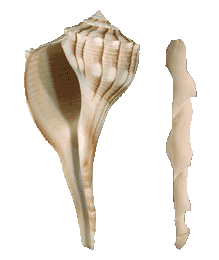 |
 |
Photographs (left to right): Seneca Rock, West Virginia; Fish Mountain, Utah; Ten Sleep Canyon, Wyoming
Wampum: History
Article Provided Through The Courtesy of Tara Prindle and NativeTech. Edited and modified by R. Hamell. Shell beads come in many traditional shapes and sizes, including small discs or hishi beads. Before contact with Europeans, shell beads were either disk shaped, or barrel shaped, usually made from the whelk's spiraling inner columella. Other shapes of shell beads include tubes, and other forms resembling a ball, cone, diamond, square, or hourglass.
 |
Figure 1 Different Methods Of Drilling Wampum Beads (cross-sections)A. Prehistoric – drilled from both ends (top). B. Historic – bored with a metal drill from one end (bottom). |
Shell beads have long had cultural significance to the Native Americans of southern New England; shell beads in the Northeast have been found which are 4500 years old. These shell beads were larger and relatively uncommon because drilling the material was difficult with stone drill bits. This earlier bead, proto-wampum, was traded within ceremonial contexts, in part for the connections of shell with water and its life giving properties.
Wampum from Middle and Late Woodland periods (beginning around AD 200) had a robust shape, about 8mm in length and 5mm in diameter, with larger stone-bored holes of more than 2mm that were drilled from both ends. The result was often a misalignment of the bored-hole (Figure 1A). Wampum beads of the mid-1600's average 5mm length and 4mm diameter with tiny holes were bored with European metal awls average 1mm. The longer awls permitted drilling the entire length of the wampum from one end giving the bead a straight bore (Figure 1B). Seneca's in New York after European contact during the late 1600's had increasing numbers of shell beads which measured approximately 7mm length and 5mm diameter, having metal-drilled holes with a diameter of just under 2mm. See Tools For Making Dutch Wampum by Orhand (1975: 84).
The word "Wampum" comes from the Narragansett word for 'white shell beads'. Wampum beads are made in two colors: white ("Wòmpi") beads ("Wompam") from the Whelk shell ("Meteaûhock"), and purple-black ("Súki") beads ("Suckáuhock") from the growth rings of the Quahog shell ("Suckauanaûsuck").

Figure 2
The Bivalve - Mercenaria mercenaria
The quahog shell used to produce purple wampum and other shell pendants is exclusively the species with the Latin name Mercenaria mercenaria. It is a species of bivalve (clam) that is common along the Atlantic and Gulf coasts of the United States . The purple areas (see Figure 2) of the shell were used to make the purple wampum , whereas, the white wampum was made for the gastropod (snail) Whelk genus called Busycon, derived from the Latin, Busycon, meaning large fig, a reference to the shell’s general shape.
 |
Figure 3
The Lightning Whelk - Busycon perversum pulleyi.
This species has the distinction of being the State Shell of Texas (1987).
There are several types of Whelk used to make the white beads and pendants with the Latin genus Busycon. In southern New England beads are often manufactured from two local species: Busycon canaliculatum (Channeled Whelk) and Busycon carica (Knobbed Whelk), which both inhabit the waters from Cape Cod southwards to Florida. Early historic Iroquois wampum also originates from the species Busycon sinistrum (Lightning Whelk: Figure 3) along the coast from New Jersey through Florida around through the Gulf, and also from the species Busycon laeostomum (Snow Whelk) who's habitat ranges from New Jersey down to Virginia (Pendergast 1983: 97-112). The white wampum was made by cutting and grinding sections of the central spiral of the whelk called the columella (see Figure 3).
Some early historic documents contain inaccurate references to the shells being of periwinkle or muscle shell, sometimes mistaking the beads themselves for porcelain or bone. The periwinkle shell was not even introduced to the New England coastline until the late 1800's (Krepcio, 2001: personal communication).
European traders and politicians, using beads and trinkets, often exploited gift exchange to gain Native American favor or territory. With the scarcity of metal coins in New England, Wampum quickly evolved into a formal currency after European/Native contact, it's production greatly facilitated by slender European metal drill bits. Wampum was mass produced in coastal southern New England. The Narragansetts and Pequots monopolized the manufacture and exchange of wampum in this area.
